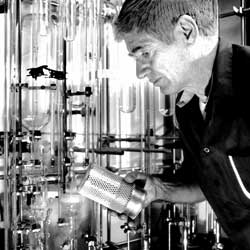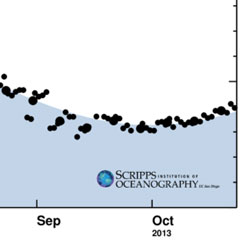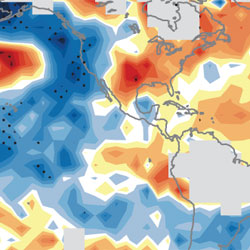Breakthrough after field project collects richly detailed ice core records from Antarctica
Wendy and Eric Schmidt Award $500,000 Grant to Keeling Curve
Supports continued operation of the iconic measurement series
As Told by the American Museum of Natural History…
The story of the Keeling Curve is beautifully animated in this new video. The American Museum of Natural History will host a Google+ Hangout Sept. 9, 2014 on the topic of the Keeling Curve. [youtube https://www.youtube.com/watch?v=0Z8g-smE2sk&w=560&h=315]
A note on recent readings
In response to a recent reader comment about wide fluctuations in CO2 readings at Mauna Loa, Ralph Keeling and Stephen Walker of the Scripps CO2 Group gave the following answer: It’s fairly normal, especially in the summer time, to see strong afternoon “dips” in the CO2 concentration. The dips are generally caused by upslope winds that that are depleted in … Read More
How are CO2 Data Processed?
Scientists make CO2 measurements in remote locations to obtain air that is representative of a large volume of Earth’s atmosphere and relatively free from local influences that could skew readings.
How do CO2 levels relate to ice ages and sea-level?
In a recent comment, a reader posted a graphic in which CO2 and sea-level rise appear to be correlated throughout the last 700,000 years.
Why Don’t Global Surface Temperature Trends Match Atmospheric CO2 Increases?
Question submitted to Scripps Oceanography science magazine explorations now by Ruben M., Watsonville, Calif. Great question Ruben! The surface temperature we experience every day is not expected to perfectly track CO2 because CO2 isn’t the only factor driving climate change. Still, it is quite an important factor, and the overall rise in temperature does roughly follow the overall rise in CO2. … Read More
What Does 400 ppm Look Like?
As atmospheric carbon dioxide levels rise, scientists look back four million years for answers on what to expect from climate
Solving the Mysteries of Hiatus in Global Warming
Global mean temperatures have been flat for 15 years despite the increase in heat-trapping greenhouse gases, but a new Scripps study shows cooling in the equatorial Pacific Ocean explains the discrepancy






